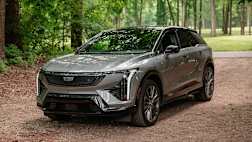What does PHEV stand for?
‘PHEV’ stands for ‘Plug-in Hybrid Electric Vehicle’, a type of electrified vehicle that has both an internal-combustion engine (ICE) and a battery-powered electric motor, combining both to deliver maximum power and efficiency to the car.
The PHEV must be plugged into an external charging source in order to charge the battery when it’s drained.
Getting your head around what an Electric Vehicle (EV) is can seem relatively simple - it does what it says on the tin, and is a car that runs on electricity, like a mobile phone with wheels - but other terms may get bandied about, leaving you with questions like ‘What is a plug-in hybrid?’, ‘What does PHEV stand for in cars?’ and ‘How do PHEV cars work?’
A standard, non-PHEV hybrid has both a petrol-powered ICE and a battery-powered electric motor, the latter typically kicking in when some extra power is needed (driving in all-electric mode for short distances is also possible with most models, while the self-charging battery also gathers energy from a process called regenerative braking).
PHEVs are a little different in that the battery-powered electric motor is the main thing that powers the car, while the ICE is on standby as an emergency back-up for when your battery starts to run out of juice.
The other major difference, which you may have guessed from the name, is that PHEVs plug in to an external power source to charge the battery - typically a wallbox charger or a standard electricity socket at home, or a charger at a public-charging station (including fast chargers, for those who like to charge and go as quickly as technologically possible).
A fully charged battery in a PHEV, like Mitsubishi’s Outlander PHEV, will typically give you around 50-60km of travel before recharging is required, which is more than enough for most occasions, considering the average Australian will only travel about 36.4km per day.
PHEVs are often described as a good stepping stone for people who aren’t ready to make the leap to a full EV - potentially due to the current high cost of EVs, or the fact they may have range anxiety - and while they’re not completely emissions-free, they do release far fewer greenhouses gases than a standard hybrid or ICE vehicle.
If you’re after a plug-in hybrid, Australia already has quite a few PHEV models available on the market, with more set to arrive in 2022 and beyond.
Below you’ll find a list of some of the best PHEVs available in Australia right now.
MG HS PHEV
_0.jpg)
Price: $46,990, plus on-road costs
MG's mid-size SUV recieved a flagship plug-in hybrid variant in the recent past, and in 2022 will bring the price down even further with a more affordable Core variant to complement the top-spec Essence, which itself was already one of the most affordable PHEVs in Australia. Offering great value and improved driving dynamics over the rest of the HS range, there's plenty of reasons to consider one, too.
Kia Niro PHEV S
.jpg)
Price: $46,590, plus on-road costs
This small SUV from Kia also comes in hybrid and EV models, with the PHEV model offering up 58km of all-electric driving capability. There’s a 8.9kWh battery pack, and the electric motor alone offers up 44.5kW of power and 170Nm of torque. While Kia offers this model in a more practical visage than its Hyundai Ioniq hatch relation, stay tuned for the new generation model later in 2022.
Kia Sorento GT-Line PHEV
.jpg)
Price: $80,330, plus on-road costs
The Sorento PHEV is a standout, offering both seven seats and up to 68km of fully electric driving range. It pairs a 67kW/304Nm electric motor with a 1.6-litre turbocharged four-cylinder engine for a combined output of 195kW/350Nm, driving all four wheels. Thus far, the PHEV Sorento is only available in the top GT-Line trim, and has made Kia the only brand to offer a car with diesel, petrol, self-charging hybrid, and plug-in hybrid options.
Volvo XC40 Recharge

Price: $66,990, plus on-road costs
The Recharge packs in a number of great features - 20-inch alloy wheels, a 14-speaker Harmon Kardon stereo, sat nav, leather seats, power front seats - and has a 1.5-litre, three-cylinder turbo engine coupled with 60kW/160Nm electric motor. The 10.7kWh battery gives the Recharge 46km of all-electric range in an attractive scandinavian premium SUV shape.
Lexus NX 450h+
.jpg)
Price: $89,900, plus on-road costs
With a massive 18.1kWh battery pack, the Lexus NX 450h+ has one of the longer ranges in the PHEV world, with a claimed 87km of fully electric driving on offer. While this is measured to the more lenient NEDC standard, our testing has found you can expect around 65km in the real world, which is still excellent. As the first Lexus PHEV it brings some new innovations for the brand, and the NX sports smooth driving dynamics and an electrified all-wheel drive system.
Mitsubishi Eclipse Cross PHEV

Price: $46,490, plus on-road costs
Offering a flexible PHEV drivetrain at a compelling price, the Mitsubishi Eclipse Cross PHEV is particularly notable as one of only a few PHEV models able to charge up using a DC fast connection via the Japanese-standard CHAdeMO plug. This means its 13.8kWh battery can be charged to 80 per cent from the reserve level in just 22 minutes, and on a full charge it is claimed to travel up to 45km under electric power alone, not bad for a small SUV. The Eclipse Cross is also all-wheel drive via electric motors on both axles, offering an array of driving modes to suit most conditions.
Porsche Cayenne E-Hybrid
.jpg)
Price: $147,400, plus on-road costs
The Cayenne E-Hybrid hasn’t got as much all-electric range as some other models - around 47km - but the 3.0-litre turbo petrol six-cylinder engine paired to an electric motor delivers a maximum 700Nm of combined torque, making it a force to be reckoned with.








.jpg)
.jpg)



.jpg)
.jpg)
jpg.jpg)



